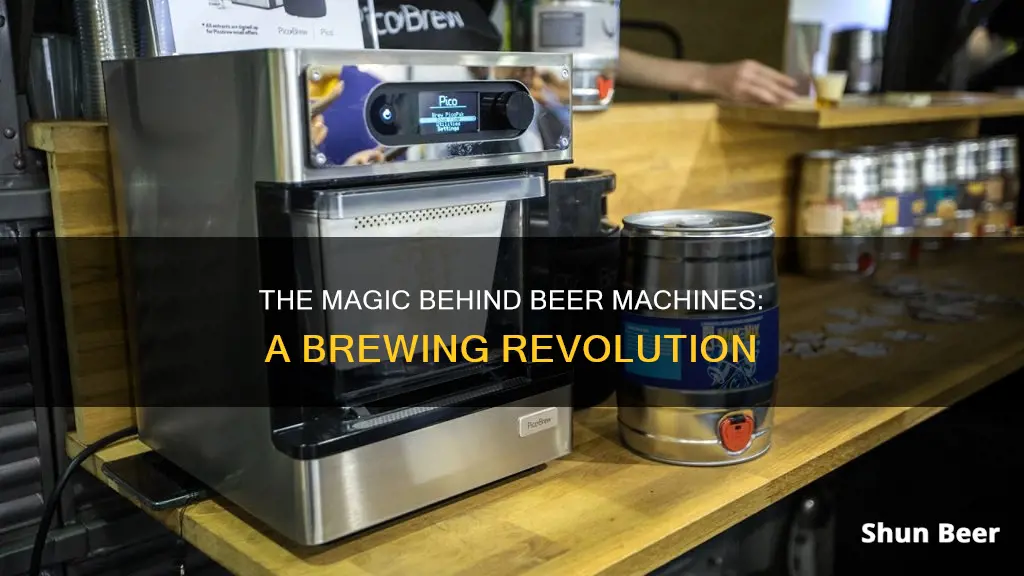
There are several types of beer machines, from those used in pubs and bars to those designed for home use. Beer machines can be used to pump beer from a cask, or to dispense beer from a keg. Some machines can even be used to brew beer at home. The basic components of a beer machine are a cooler, keg, coupler, gas, tubing, and faucet. Beer machines may also use magnets to seal the beer glass, or a bag-in-bottle principle to keep beer fresh.
| Characteristics | Values |
|---|---|
| Purpose | To pump beer from a cask |
| Inventor | John Lofting |
| Power Source | Manual, electric, or gas |
| Mechanism | Beer is pumped through a flexible tube to the spout |
| Components | Cooler, keg, coupler, gas, tubing, and faucet |
| Beer Storage | Kept in a chilled keg or SUB Keg |
| Dispensing Method | Beer tap, Bottoms Up dispenser, or Beer tower |
What You'll Learn

The beer engine: a device for pumping beer from a cask
The beer engine is a device used for pumping beer from a cask, usually located in a pub's cellar or basement. It was invented by John Lofting, a Dutch inventor, merchant and manufacturer who moved from Amsterdam to London in 1688. Lofting patented several inventions, including a fire hose and engine for extinguishing fires. The London Gazette described his beer engine as a "very useful engine for starting of beers and other liquors which will deliver from 20 to 30 barrels an hour".
The beer engine is typically manually operated, with the term 'handpump' used to refer to both the pump and its handle. The handle is used to draw the beer through a flexible tube to the spout, where the glass is placed. Modern hand pumps may be clamped to the edge of the bar or integrated into the bar top. A pump clip is usually attached to the handle, displaying the name of the beer and sometimes the brewery, beer type and alcoholic strength.
The handle of a handpump has become a symbol of cask ale. This style of beer has continued fermentation and uses porous and non-porous pegs, called spiles, to release and retain gases generated by fermentation, achieving the optimal level of carbonation. Cask-conditioned beers have lower carbonation than standard beers as they are served at a warmer temperature. If a cask-conditioned ale were served through a standard dispensing system, the gas pressure and colder temperature would increase carbonation, disrupting the ideal balance of flavours.
In the 1970s, some breweries attempted to replace cask-conditioned ale with keg versions, disguising keg taps with cosmetic hand pump handles. This practice was opposed by the Campaign for Real Ale and was eventually discontinued.
The Science of Sipping: Beer Steins Explained
You may want to see also

Draft systems: getting beer from keg to glass
A draft beer system is a device for pumping beer from a cask or keg. In any draft system, there are six main components: a cooler, a keg, a coupler, gas, tubing, and a faucet. These work together to ensure the beer is properly chilled, carbonated, and poured with an appropriate foamy head.
Firstly, beer needs to be kept cold to prevent spoilage and warm, foamy pours. Kegs are usually kept in walk-in coolers in bars and restaurants. Kegs come in a variety of sizes, shapes, and materials, but beer made in the US is typically packaged in 5-gallon, 7.75-gallon, or 15.5-gallon kegs made of stainless steel.
To get beer out of the keg, gas pressure is applied to the top surface of the liquid, which pushes the beer from the bottom of the keg up through a metal tube and out of the valve. The valve requires another piece of equipment called a coupler, which connects to two tubes: one that brings gas to the keg and one that lets the beer flow out to the glass. Most bars and restaurants use canisters of pure bottled carbon dioxide and nitrogen for this purpose.
From the keg to the faucet, beer travels through vinyl or polyethylene tubing, which may be chilled to ensure the beer stays cold. The faucet has another valve, which is controlled by pulling the tap handle. The tap needs to be opened completely to avoid creating turbulence that will cause foaming in the glass.
The whole system is held in a delicate balance, hinging on the amount of pressure that's applied to the keg and the resistance imposed by tubing, gravity, and hardware. The temperature and amount of carbonation in the beer also matter and must be carefully calibrated to avoid overcarbonation or flatness.
The Beer Machine
The Beer Machine is a closed system that allows for continuous brewing without the need for cleaning after every brew. It is designed to be simple and mess-free, requiring users to just add water, yeast, and a Beer Mix to begin brewing. The machine includes a carbonation unit for conditioning with CO2 and dispensing carbonated draft beer on tap.
Beer Subscriptions: How Do They Work?
You may want to see also

Bottoms Up Beer Dispenser: using magnets to seal and fill cups
The Bottoms Up Beer Dispenser is a novel draft beer pouring technology designed to speed up service and improve hygiene in busy bars. The system involves placing a glass with a hole in the bottom onto a dispensing platform. The glass has a metal magnetic ring that seals the underside. When the glass is placed on the dispenser, magnets lift the ring away, and beer is quickly and automatically filled from the bottom up. The magnets then drop back into place, sealing the hole and preventing leakage.
The main benefit of this system is speed. It takes around ten seconds to pour a pint using a traditional tap, but a single server with four Bottoms Up taps can fill up to 44 pints per minute. This increased speed can lead to significant revenue increases, especially in busy venues such as stadiums and festivals. The system also improves server convenience, as the pre-programmed pouring technology means staff can multitask without worrying about overflows.
Hygiene is another advantage of the Bottoms Up system. Unlike traditional taps, there is no long spout or nozzle that can come into contact with multiple glasses, reducing the risk of spreading germs. The single-use magnets can also be customised with branding and promotional offers, providing portable advertising for the venue.
However, there are some drawbacks to the Bottoms Up dispenser. The system requires specially made cups, glasses, and pitchers, and the magnets must be replaced with each pour, leading to higher costs and more waste. Some users have also reported leaks and accidental spills due to the bottom cap being dislodged. Despite these issues, the Bottoms Up Beer Dispenser offers a unique solution to the challenges of pouring draft beer in high-volume settings.
Beer Coolers: Understanding the Science of Cold
You may want to see also

The SUB: a beer tap with a bag-in-bottle principle
The SUB is a home beer tap system that uses a bag-in-bottle principle to deliver fresh, draught beer. The system consists of a small, sleek appliance that houses a 2-litre SUB keg, which is a type of bag-in-bottle container.
The SUB kegs are small, portable containers that hold two litres of beer, equivalent to about four 50cl pints. Each keg is placed into the SUB appliance, which keeps the beer chilled and ready to be served. The beer is dispensed through a tap, which is located on the appliance, and poured directly into a glass.
The SUB system offers a variety of beer options, including popular brands such as Heineken, Amstel, and Birra Moretti. The kegs are designed to be easily swapped out, allowing users to enjoy different types of beer without any complicated setup.
One of the key advantages of The SUB is its convenience and ease of use. There is no need for a separate dispenser machine, as the kegs can be placed directly in a fridge. Additionally, the system requires minimal maintenance and cleaning, as it is a completely closed system. Users can simply add a new Beer Mix and water to start brewing a new batch of beer.
The SUB provides a unique experience of enjoying draught beer at home, with the convenience of a compact, easy-to-use appliance.
Beer Batters: How Do They Work?
You may want to see also

Beer towers: portable beer taps for self-service
Beer towers are an innovative way to bring the bar to the customer's table. These self-service taps are a convenient and luxurious addition to any seating area, converting flat surfaces into a self-pour station. The towers are usually made of high-quality stainless steel with a mirror finish, adding an eye-catching aesthetic to the table.
The technology behind self-serve beer towers is similar to that of mobile tables, where an RFID reader and touch screen are integrated into a single, easy-to-install enclosure. This allows customers to load their RFID cards and dispense their desired beverage, providing a private and exclusive experience.
One of the main benefits of self-serve beer towers is the increased efficiency and reduced staff requirement. With self-pour technology, establishments can operate with less staff while maximising beverage sales. Staff can focus on other tasks and providing excellent customer service, resulting in higher tips.
Another advantage is the boost in profits. Customers tend to taste a variety of drinks before finding their favourite, increasing overall beverage consumption and spending. Additionally, self-pour reduces product waste by eliminating free samples and minimising spillage.
Self-serve beer towers offer a unique and fun experience for customers, encouraging them to return. The freedom to sample and pour their own drinks, as well as the social aspect of discussing flavours with friends, makes for an enjoyable and interactive drinking experience.
Overall, portable beer towers provide a convenient, efficient, and profitable solution for establishments, while offering customers a novel and engaging way to enjoy their favourite beverages.
The Beer Droid: Brewing Process Decoded
You may want to see also
Frequently asked questions
The six main components of a draft beer system are the cooler, keg, coupler, gas, tubing, and faucet.
A beer engine is a device for pumping beer from a cask, usually located in a pub's cellar. It is normally manually operated, but electrically powered and gas-powered pumps are also used. The beer engine is located below the bar, with the handle used to draw the beer through a flexible tube to the spout.
The Bottoms Up Beer Dispenser uses magnets to seal and unseal the beer glasses. The glasses have a fridge magnet-style floppy circular strip that sits on the hole at the bottom. When the cup is placed on the dispenser, the magnet is pushed up, breaking the seal and allowing beer to flow into the cup.







